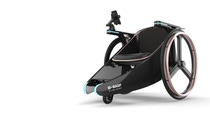Plastics & Rubber
Ren Chair
Material innovations, combined with the availability of advanced design systems, are creating new possibilities for wheelchair users and caregivers to enjoy more freedom and versatility.
Lightweight plastics for higher performance
Lightweight materials from BASF used in the Ren Chair offer greater convenience and comfort for both users and caregivers. Lighter weight offers ease of mobility and also helps caregivers reduce the risk of injuries. The dual-density seat, made with BASF’s Elastoflex® W flexible foam polyurethane system (PU), provides greater comfort to the user, owing to the high elasticity and compressibility of the material. Furthermore, the artificial leather in the seat cover, made with Elastollan® thermoplastic polyurethane (TPU) provides excellent haptics and enables easy cleaning.
New digital tool and durable materials for enhanced safety
A new smartphone app, which is connected to the sensors and connectors of the Ren Chair, can detect the wheelchair’s movement and control the signal lights on the back, navigating users to access barrier-free facilities. The sensors and connectors, made with Ultramid® polyamide (PA) and Ultradur® polybutylene terephthalate (PBT) are more robust against damage, such as breaks and cracks, thereby improving users’ safety on the road.
BASF’s high-performance material innovations used in the Ren Chair offer superior mechanical properties, including high strength, abrasion resistance, and chemical resistance. For example, the seat back, made of Elastollan® TPU filament, provides comfortable and long-lasting seating with postural support, owing to its strength and durability.
Versatile materials enable design freedom for complex geometries
BASF’s material innovations also enable freedom of design by using molding or 3D printing technology to produce complex shapes. Additionally, compared to traditional materials, high-performance materials such as TPU, expanded thermoplastic polyurethane (E-TPU), PU, and engineering plastics are simple to process and provide greater ease of coloring and decoration for more stylish designs, while maintaining the functionality. For instance, Elastoflex W possesses good flowability, which enables freedom of design for complex geometries.
The casters and caster housing in the wheels have been developed with the use of BASF’s proprietary simulation tool, Ultrasim®. The tool provides precise calculations of the anisotropic mechanical behavior of material solutions, which optimize production and minimize development costs.
Find out more about the Ren Chair: medical-plastics.basf.com
